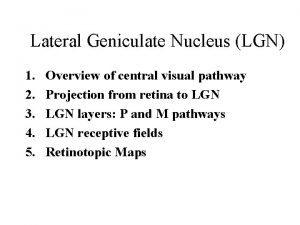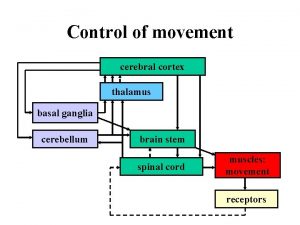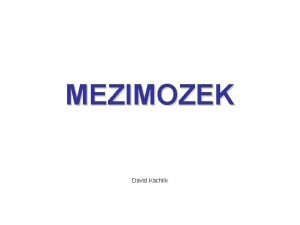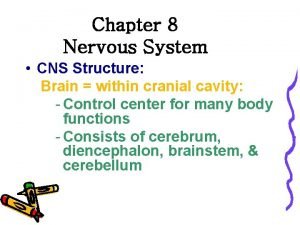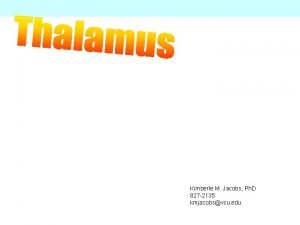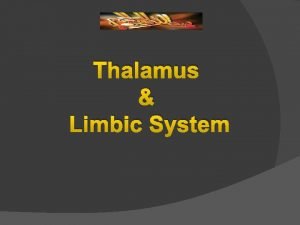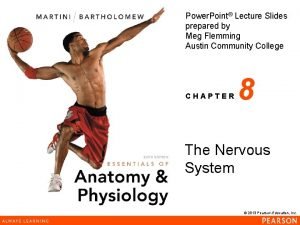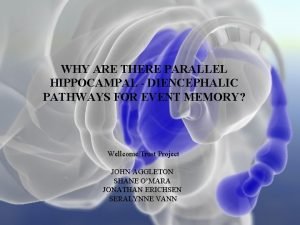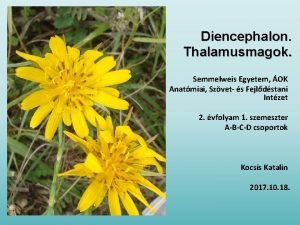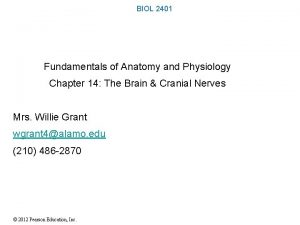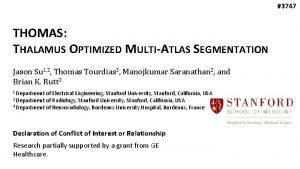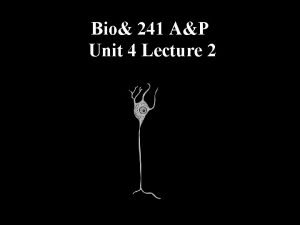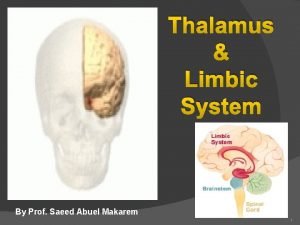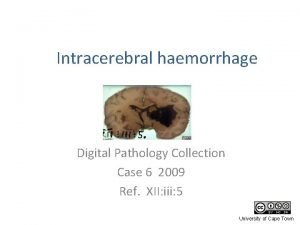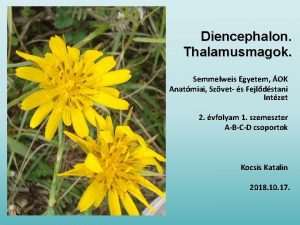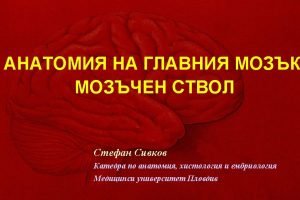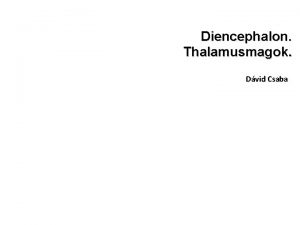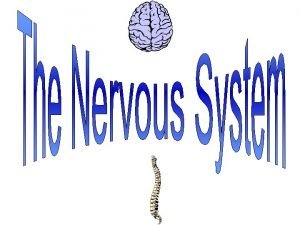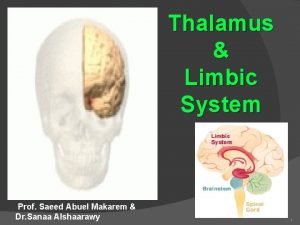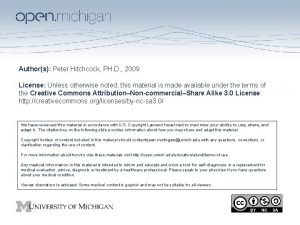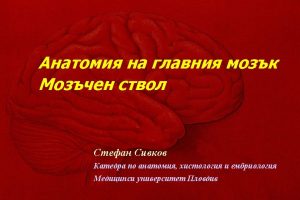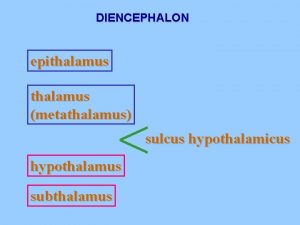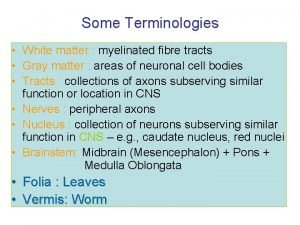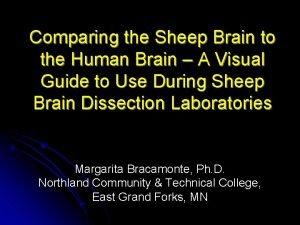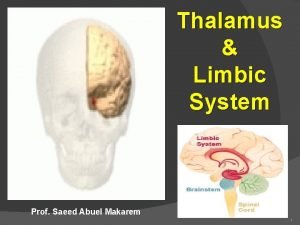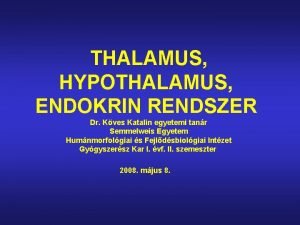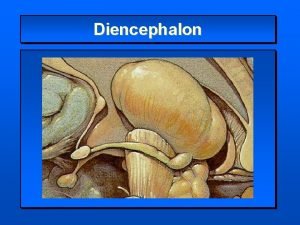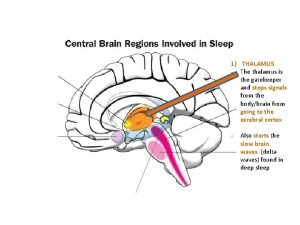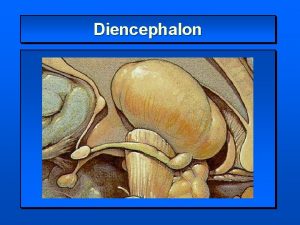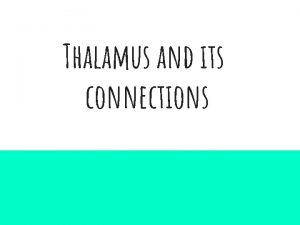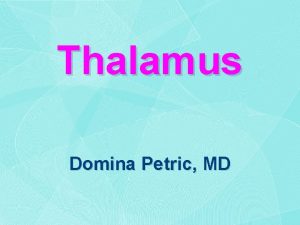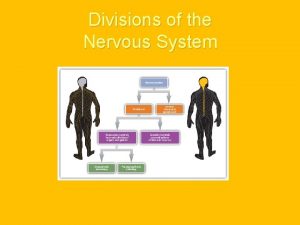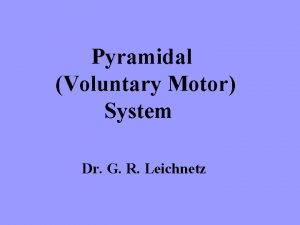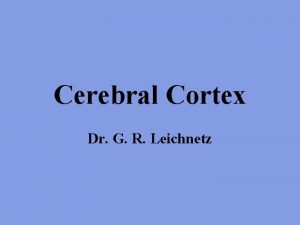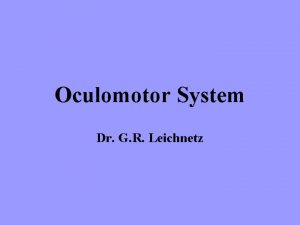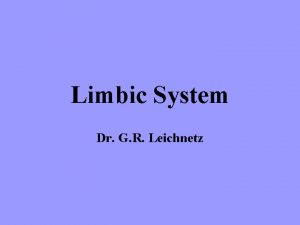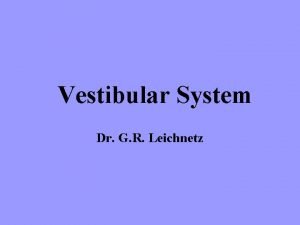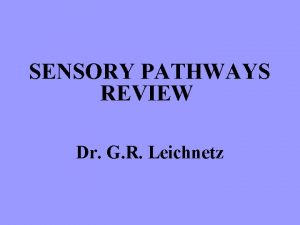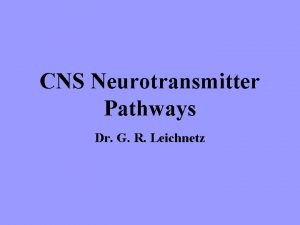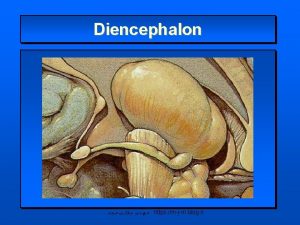Thalamus Dr G R Leichnetz Divisions of the

































- Slides: 33

Thalamus Dr. G. R. Leichnetz

Divisions of the Diencephalon Thalamus Hypothalamus Subthalamus: prerubral fields of Forel, zona incerta, subthalamic nucleus Epithalamus: pineal gland, habenula

EPITHALAMUS (Habenula, Pineal Gland) THALAMUS HYPOTHALAMUS MB

Coronal Section: Thalamus/ Subthalamus/ Hypothalamus Thalamus Subthalamus Mammillary Bodies (hypothalamus) Third ventricle

Thalamus/ Subthalamus/ Hypothalamus Posterior limb, internal capsule Thalamus Subthalamic nucleus Mammillary bodies (hypothalamus) Third ventricle

EPITHALAMUS Zona Incerta Subthalamic nucleus Prerubral Fields of Forel SUBTHALAMUS MB HYPOTHALAMUS

Epithalamus: Pineal Gland Habenular Complex

Epithalamus Pineal Stalk Pineal Gland Habenular complex Habenular Complex Pineal gland Posterior commissure Pineal stalk

The epithalamus consists of the pineal gland habenular complex. The pineal gland contains modified glial cells, called pinealocytes, that synthesize melatonin, which is released in a biological rhythm that affects activities such as sleeping and waking (jet lag). Recent evidence has shown that the suprachiasmatic nucleus of the hypothalamus (the brain’s “biological clock”), which receives direct visual input from the retina, projects to the habenular complex, which projects to the pineal gland through the pineal stalk. In the reverse direction, the pineal sends fibers to the habenular complex through the stalk to deposit melatonin in the habenula. This could represent a more direct pathway for light to influence pineal function (release of melatonin). Retina Suprachiasmatic Nucleus (“biological clock”) Habenular Complex Pineal Gland (melatonin)

Thalamus

The two egg-shaped thalami are joined across the third ventricle by the massa intermedia (interthalamic adhesion). Caudate Third ventricle Thalamus Pineal gland The massa intermedia is not a commissure. Stria terminalis

Anterior thalamic tubercle Caudate The two thalami are separated from each other by the third ventricle. The stria terminalis ST (from amygdala) Thalamus IIIrd vent Pineal gland Pulvinar SC IC runs in a groove on the floor of the lateral ventricle that separates the thalamus from the caudate nucleus.

The internal medullary lamina of the thalamus divides the thalamus into medial and lateral nuclear groups. The lateral nuclear group is further subdivided into dorsal and ventral tiers. Dorsal. T ier Ventral Tier

The internal medullary lamina (containing intralaminar nuclei) divides the thalamus into a medial nuclear group (primarily MD nucleus) and lateral nuclear group (which consists of a dorsal & ventral tiers). Medial nuclear group Lateral nuclear group Internal medullary lamina Intralaminar complex Carpenter: Human Neuroanatomy

Thalamus: Sectional Anatomy (from rostral to caudal levels)

At rostral thalamic levels: anterior nucleus is encapsulated by the internal medullary lamina; ventral anterior nucleus (VA) is in the ventral tier. Interventricular foramen of Monro Anterior thalamic tubercle ANT VA MTT MD IIIrd Vent SUBTHALAMUS

The last part of the mammillothalamic tract (MTT) from mammillary body to anterior nucleus courses through the internal medullary lamina of the thalamus. The anterior nucleus receives the MTT and projects to the cingulate gyrus. Thalamic reticular nucleus ANT MTT Thalamic reticular nucleus ANT VA The thalamic reticular nucleus consists of clusters of cells within the external medullary lamina of the thalamus. It is the only GABA-ergic (inhibitory) nucleus in the thalamus, and is the only thalamic nucleus that does not project to the cortex. It has intrinsic thalamic connections; involved in the generation of sleep “spindles” in the EEG. MTT MD

When the MD nucleus is small, the VA nucleus is transitioning into the rostral part of the VL nucleus in the ventral tier. AN T MD VA/VL MI The massa intermedia (interthalamic adhesion) is an adhesion of ependymal and glial cells across the third ventricle (not a commissure).

When the MD nucleus is largest, the VL nucleus is present in the ventral tier. LD/LP A VL MD MI The ventrolateral nucleus (VL) primarily receives input from the contralateral deep cerebellar nuclei and projects to the primary motor cortex. The mediodorsal nucleus (MD) is the largest nucleus of the medial thalamus. It receives limbic input from the amygdala and projects to the prefrontal cortex.

In the caudal third of the thalamus, the ventral posterior nucleus (VPM/VPL) are present in the ventral tier, and the CM/Pf intralaminar nuclei are seen within the internal medullary lamina. LP PUL MD VPL Subthalamus CM Pf VPM The ventral posterolateral (VPL) and ventral posteromedial (VPM) nuclei receive the spinal and medial lemnisci. They are somatotopically organized. The centromedian (CM) and parafascicular (Pf) nuclei are the largest nucleus of the intralaminar complex. CM projects to the putamen. The Pf projects to the caudate nucleus.

The pulvinar, medial geniculate, and lateral geniculate nuclei are located in the posterior (caudalmost) thalamus. PUL MGN Pineal gland Posterior commissure Pretectum LGN The lateral geniculate nucleus receives direct visual input from the retina and projects to the primary visual cortex. The medial geniculate nucleus receives auditory input thru the brachium of the inferior colliculus and projects to the primary auditory cortex.

Thalamic Connections

Basic Pattern Of Thalamic Connections Thalamocorticals Thalamus Subcortical Afferents Corticothalamics From: Kiernan and Barr All thalamic nuclei (except the thalamic reticular nucleus) have reciprocal connections with the cerebral cortex. Thalamocorticals project to lamina IV of the cortex. Corticothalamics that project back to the thalamus originate in lamina VI of the cortex. All thalamic nuclei are glutamatergic (excitatory), except the thalamic reticular nucleus (GABA).

The principal source of cortical afferents is the thalamus. Thalamocortical projections traverse the internal capsule to reach the cortex. From Noback & Demarest

The thalamus is the principal source of direct cortical afferents (corticopetal projections). The ventral tier of the lateral group contains the specific relay nuclei of the thalamus. motor relay nuclei (VA/VL) rostrally, sensory relay nuclei (VPM/VPL, MGN, LGN) caudally.

Organization of projections from the ventral tier (specific relay nuclei) to the cortex.

Cortical Efferents Corticofugal projections originate from layer V pyramidal neurons, including corticospinals, corticobulbars, corticopontines, corticostriates. O nly corticothalamics originate in layer VI. Associational Corticostriate Commissural Corticopontine Corticospinal Corticobulbar Corticothalamic There are reciprocal connections between thalamus and cortex.

The intralaminar complex is made up of subnuclei within the internal medullary lamina of the thalamus. The intralaminar nuclei receive input from the brainstem reticular formation, and project to the striatum (thalamostriates) and to the cerebral cortex (thalamocorticals). The largest of the intralaminar nuclei is the centromedian/parafascicular complex. The centromedian nucleus projects to the putamen and sensorimotor cortex. The parafascicular nucleus projects to the caudate and associational cortex.

MD Intralaminar nuclei are cell groups within the internal medullary lamina of the thalamus. MD

Intralaminar Nuclei at Caudal Thalamic Levels: CM/Pf MD Parafascicular Nucleus The centromedian and parafascicular nuclei are the largest of the intralaminar nuclei. They give rise to thalamostriates to putamen and caudate. Centromedian Nucleus CM Pf MD

The thalamic reticular nucleus is the only GABA-ergic nucleus of the thalamus. It has intrinsic thalamic connections (does not project to the cortex). Involved in generation of sleep spindles in the EEG. Thalamic reticular nucleus ANT Thalamic reticular nucleus VA MTT Intrinsic thalamic conn. ’s ZI

Clinical Correlations

Thalamic Pain Syndrome Central neurogenic pain (not caused by activity in peripheral sensory fibers) be caused by lesions that interrupt the somatosensory pathway at any level. can A destructive lesion that involves the ventral posterior nucleus of the thalamus may result in the thalamic pain syndrome characterized by exaggerated and exceptionally disagreeable responses to cutaneous stimulation.
 Lateral geniculate nucleus of thalamus
Lateral geniculate nucleus of thalamus Sulcus hypothalamicus
Sulcus hypothalamicus Thalamus
Thalamus Medial forebrain bundle
Medial forebrain bundle Thalamus function
Thalamus function Mamillothalamic tract
Mamillothalamic tract Circuit of papez
Circuit of papez Thalamus posterior view
Thalamus posterior view Thalamus nuclei
Thalamus nuclei Thalamus magok
Thalamus magok Homone
Homone Thomas thalamus
Thomas thalamus Intermediate mass of thalamus
Intermediate mass of thalamus Limbic system nuclei
Limbic system nuclei Thalamus lesion
Thalamus lesion Thalamus magok
Thalamus magok Thalamus dorsalis
Thalamus dorsalis Thalamus magok
Thalamus magok Thalamus function
Thalamus function Plvnt thalamus
Plvnt thalamus Thalamus blood supply
Thalamus blood supply Cerebellar peduncles
Cerebellar peduncles Thalamus function
Thalamus function Ncl tuberales
Ncl tuberales Nuclei of thalamus
Nuclei of thalamus Ventricles of brain
Ventricles of brain Thalamus hospital la florida
Thalamus hospital la florida Limbic system composed of
Limbic system composed of Eminentia mediana hypothalamus
Eminentia mediana hypothalamus Functions of the thalamus
Functions of the thalamus Police scotland divisions map
Police scotland divisions map Oceanic divisions
Oceanic divisions Electrical synapse vs chemical synapse
Electrical synapse vs chemical synapse Cricothyroid muscle.
Cricothyroid muscle.
